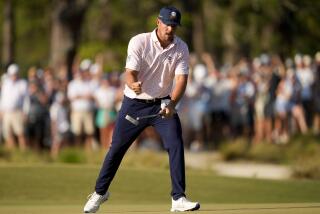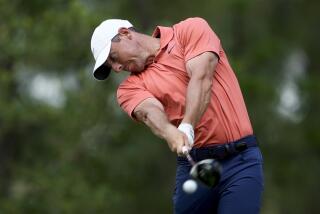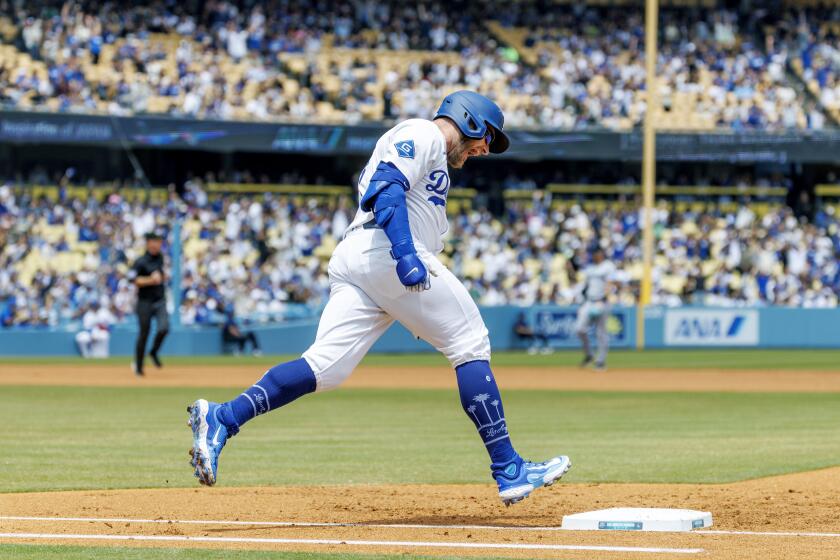This Club Could Use a Good Bouncer
- Share via
PINEHURST, N.C. — It’s just the way Tiger Woods described it. At the U.S. Open, you can’t get too high and you can’t get too low; there will be good bounces and bad bounces.
The bounces were mostly bad Friday at Pinehurst No. 2, where only five players out of the 155 who began the day saw it end with a score under par.
Rocco Mediate, who followed up his first-round 67 with a 74, served as eyewitness to enough bad bounces to last a lifetime. At least he was philosophical about it.
“One of those things,” he said.
With the course drying out in the sun, the fairways became even harder and faster and the greens remained the consistency of a sidewalk.
So the result was not unexpected. It was hard to follow the bouncing balls, and the directions they took, however unintentional, should be given high marks for creativity and invention.
Mediate deserves to be near the top of the list. He lost five shots in a seven-hole stretch, even though he probably was a victim of circumstances. For instance, at the 16th, he found himself standing in a bunker with his ball hidden in grass tall enough to bale.
His reaction: “Nasty.”
Indeed. But Mediate somehow chopped it out and even though he made a bogey, he was spared something worse.
That came two holes later at the 18th, his ninth hole, when his second shot bounced over the green and onto the paved cart path behind the hole.
Said Mediate: “It was hilarious, really.”
He wound up with a bogey on that hole too.
Actually, in the category of clubhouse shots, the true leader in the clubhouse has to be Nick Jones, the two-time All-Pacific 10 Conference player from USC playing in his first U.S. Open.
Jones hit his second shot on No. 18 off the roof of the clubhouse, wound up with a seven, a 40 for the nine holes and a 75 for the day.
It wasn’t Phil Mickelson’s grandest day either. Three three-putts, missing a thee-footer at the 15th, a five-footer at the 16th and a six-footer at the 17th added up to a load of trouble for Mickelson, who finished with a 77.
Even when he hit it in the right place, it turned out to be the wrong place. At the 16th, when Mickelson hacked the ball out of the rough to what should have been the haven of the green, the ball landed, started rolling, picked up speed and didn’t stop until it found the bottom of one of those run-off areas that surround the hump-backed greens.
Afterward, Mickelson lamented his putting and said anyone near the lead who shoots 36 pars the rest of the way has an outside chance of winning.
Just when it seemed that Olin Browne’s chances were becoming more outside all the time, he steadied himself and got into the clubhouse safely with a share of the lead.
With all those golf balls bouncing off the roof and the cart path, just getting into the clubhouse safely should have been reward enough.
Browne’s moment of truth was at the par-three sixth, otherwise known as 220 yards of hurt. First, Browne hit it into the bunker on the right. Then he hit it across the green into the bunker on the left.
The ball was only a step or so from the right edge, so his downswing was steep. All he could do was land the ball on the green as best he could, which didn’t turn out to be good enough.
It traveled down the slope off the other side, from where Browne chipped about 20 feet short of the hole. From there, he rammed the ball into the hole to conclude one of the best double bogeys you’ll ever see.
Meanwhile, David Toms dropped out of sight in spectacular fashion, playing his last two holes in five over par and fell from a tie for first to a tie for 17th. When he hit his chip on the ninth, his closing hole, the ball rolled back to where he was standing.
On the bright side, he was still standing. And not to be underestimated, he made it back into the clubhouse safely.
More to Read
Go beyond the scoreboard
Get the latest on L.A.'s teams in the daily Sports Report newsletter.
You may occasionally receive promotional content from the Los Angeles Times.










